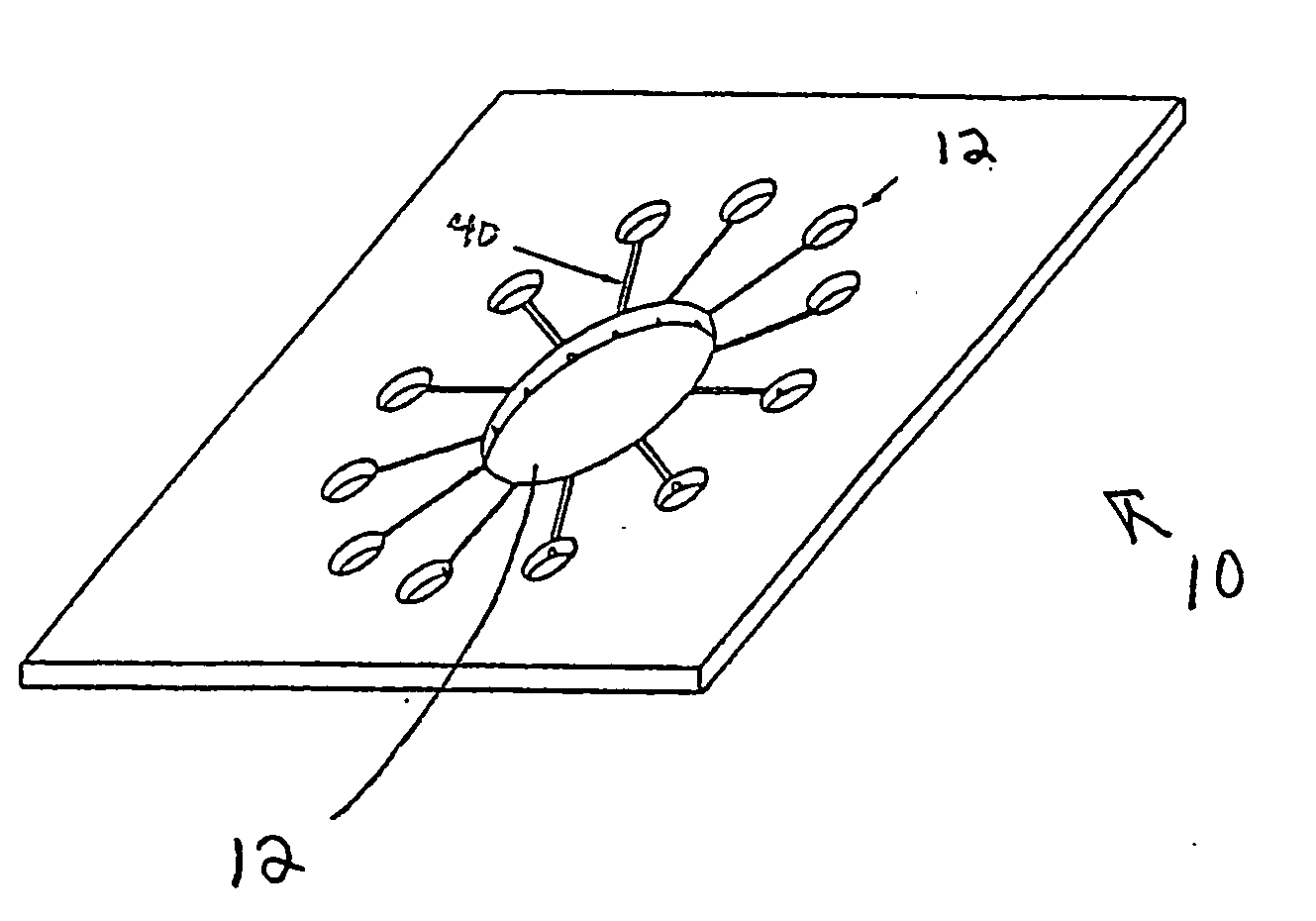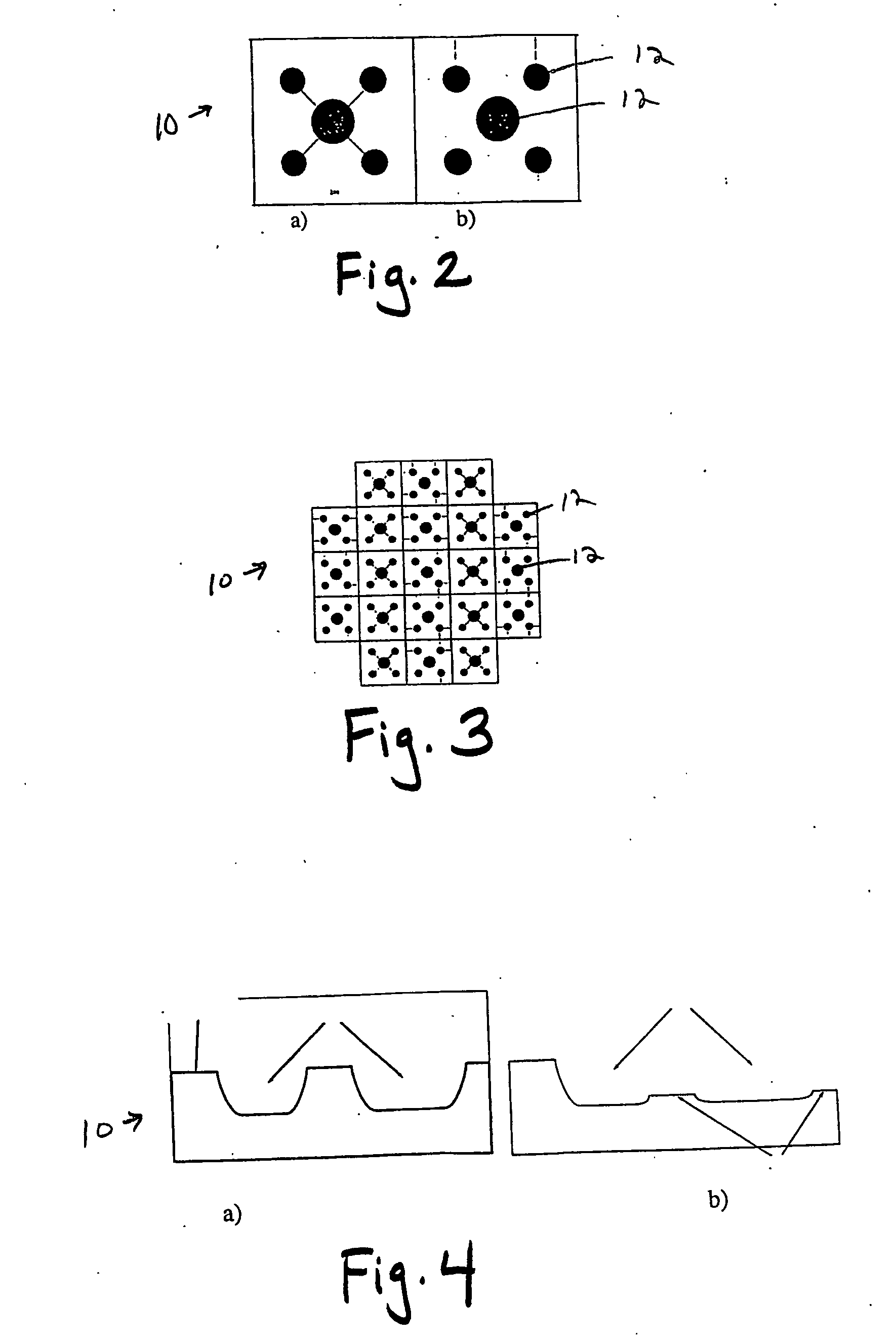Personal monitor to detect exposure to toxic agents
a technology of toxic agents and personal monitors, applied in the field of microsensor technology, can solve the problems of immune system weakening, affecting the detection effect of toxic agents, and individuals being more susceptible to deleterious effects,
- Summary
- Abstract
- Description
- Claims
- Application Information
AI Technical Summary
Benefits of technology
Problems solved by technology
Method used
Image
Examples
example 1
Production of One Embodiment of the Device of the Present Invention
[0153]FIG. 2 shows the CAD layout of the chambers wherein two chips constitute the top and bottom of the device. The bottom (FIG. 2a) chip measures 18 mm square after separation from the rest of the wafer. The circular chambers and diagonal capillaries are 200 μm in depth. The vertical lines in (FIG. 2b) of the device are air escape capillaries measuring 1 μm in depth and 2 μm in width. The two parts of the sensor unit are bonded face to face, producing the micro-fluidic device from the two micro-fluidic glass chips. The CBMD device was designed using Tanner Research, Inc. CAD tools, and is produced in Borofloat glass using MEMS based micro-machining techniques.
[0154] The micro-fluidic device utilized different diameter conduits to provide fluid flow into the sensing chambers, and allow air to escape while maintaining liquid in the assay chamber. To provide this information and data, a model of the conduits can be...
example 2
Cholinesterase Activity Characterization
[0163] The device is based on the miniaturization and adaptation of the cholinesterase chemistry described below. To reduce the size and increase the ease of use, the reactants were dried and / or immobilized at the MOPAD sensing sites. Applicants have examined methods to optimize the immobilization procedure of the substrates, PTC / BTC and DNTB, at the sensing site including: lyophilization (freeze-drying), air-drying, and immobilization of the enzyme using a 2.5% glutaraldehyde solution. The immobilization process yielded promising data. The enzyme was added in excess and immobilized on a microtiter plate. After substrate was added, washed, and added again, the enzyme activity remained nearly constant. This has been repeated several times with three washes between each substrate addition. Such a system, when integrated into the MOPAD, enables continuous monitoring over long periods of time, rather than being a single-use device. Chemical engi...
example 3
[0181] Artificial substrate Butyrylthiocholine (BTC) or acetylthiocholine (ACT), depending on whether BuChE or AChE is to be detected, is hydrolyzed in presence of the active enzyme to form thiocholine, which reacts with 5,5′-dithiobis-2-nitrobensoic acid (DNTB) to form yellow 5-thio-2-nitrobenzoate that possesses an absorbance peak at 405 nm. The rate of change in absorbance, A-405, is directly proportional to the cholinesterase activity.
[0182] The BTC, and the ACT enzymatic substrates and the controls were purchased from Sigma-Aldrich and used for the detection of plasma butyrylcholinesterase enzyme, also known as ‘pseudo’ cholinesterase, respectively for the ‘true’ acetylcholinesterase from RBCs. The enzymatic reactions were monitored using a BioTek Elx800 plate reader able to measure kinetic readings at 405 nm. The slope of the calorimetric reaction was computed and plotted as mOD units per minute.
[0183] Several tests were performed to evaluate the ability to photometrically d...
PUM
| Property | Measurement | Unit |
|---|---|---|
| volumes | aaaaa | aaaaa |
| concentrations | aaaaa | aaaaa |
| concentrations | aaaaa | aaaaa |
Abstract
Description
Claims
Application Information
 Login to View More
Login to View More - R&D
- Intellectual Property
- Life Sciences
- Materials
- Tech Scout
- Unparalleled Data Quality
- Higher Quality Content
- 60% Fewer Hallucinations
Browse by: Latest US Patents, China's latest patents, Technical Efficacy Thesaurus, Application Domain, Technology Topic, Popular Technical Reports.
© 2025 PatSnap. All rights reserved.Legal|Privacy policy|Modern Slavery Act Transparency Statement|Sitemap|About US| Contact US: help@patsnap.com



